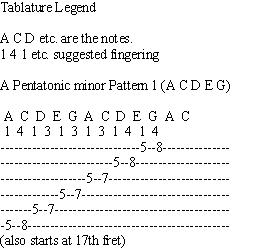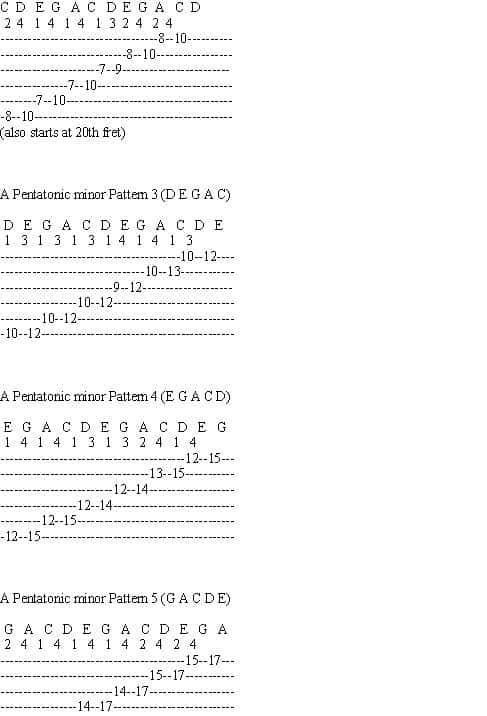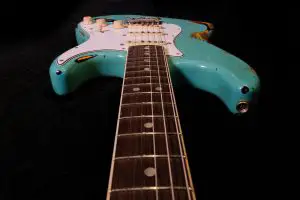In music, a pentatonic scale is a scale with five notes per octave.
Pentatonic scales are very common, and found all over the world: in the tuning of the Ethiopian krar and the Indonesian gamelan, in the melodies of African-American spirituals and of French composer Claude Debussy.
Do you like BB King? He uses the pentatonic scale. Hell, Eric Johnson, Steve Vai, and practically all of the blues greats use the pentatonic scale at some time or another.
One of the most common pentatonic scales, sometimes called a major pentatonic scale, can be constructed in many ways. A simple construction takes five consecutive pitches from the circle of fifths; starting on C, these are C, G, D, A, and E. Transposing the pitches to fit into one octave rearranges the pitches into the major pentatonic scale: C, D, E, G, A:
A minor version of the pentatonic scale is obtained by using the same notes as in the major pentatonic scale, but starting one step lower to obtain the tonic note; an A minor pentatonic scale is A, C, D, E, G:
The pentatonic blues scale is the minor pentatonic with a lowered fifth.
For those of you who are sick and tired of playing A pentatonic minor at the 5th fret or E pentatonic minor at the 12th fret, here is the tab for these scales covering the entire fretboard.
Take a look below at the (A minor) pentatonic scale.
This is one of the most important scales to learn. Before you do anything else, you need to memorize the fingering pattern below. Led Zeppelin, Jimi Hendrix, Van Halen and just about everyone else have used this scale in some variation or another to play lead guitar.
We will be using this scale for a while to let you become familiar with the guitar fretboard and to build your foundation.
If you want to play a solo, you need to know the minor pentatonic scale. It has a 3b, which makes it a minor scale. And it consists of only 5 tones, that is why it is called penta-tonic (penta = five).
Knowing all of these patterns will greatly enhance your playing and open up new tonal possibilities that you may have never heard before.
The pentatonic scale in one position is like giving the artist only a stick of charcoal to draw with. The charcoal can still draw an amazing and even photorealistic and expressive picture.
The same holds true with playing in all positions of the pentatonic scale in any given key. In short, knowing how to play the pentatonic scale in all 5 positions of any given key can create a more colorful/tonal masterpiece in the hands of a masterful artist.

A Pentatonic minor Pattern 2 (C D E G A)

Now, as you get familiar with these patterns and begin creating your own licks, you’ll need to change your fingering in some spots. Don’t be afraid to experiment.
For example, If you can’t bend the 1st string with your pinky, change your fingering and do the bend with your 3rd finger. Play the way YOU feel is the most comfortable.
Anyway, the pentatonic scale is great. No matter what you play it sounds right, you don’t ever have to worry about hitting a tritone and making your solo suddenly sound out of key. It is totally not a waste of time.
Most non-western music prior to the twentieth century was based off a 5-note scale. It isn’t the major pentatonic scale that you hear now but it was still a 5-note scale. Try listening to some old Chinese music for something that would sound more innovative if applied to western music.
The beauty of the pentatonic scale is that it’s simple to learn and play and easy to improvise with while not making things sound out of key. I personally think it sounds better with well-placed blue notes and other interpretive practices thrown in (like bends, slides, and slurs).
It sounds like you have blues burnout. A lot of mediocre blues guitarists produce nearly identical sounding solos since they don’t put in many (if any) sweet notes to make the music more interesting. Hell, even some of the blues greats played some really boring solos by today’s standards.
With that said, the pentatonics can make some very interesting and unique sounding music but they just need a novel interpretation to make them sing. I’m sure someone will come along with some suggestions of performers who have unique and interesting interpretations of these types of scales.
Most guitarists tend to learn it first (I did) because it’s the easiest scale (less notes) and does truly point out the most “in” notes you can play in any given key. I think it’s more attractive scale, because it is the basics behind working with a dark, minor sound (as opposed to the happy major sound.)
I can’t explain the thrill when I discovered if you add a few notes here and there, you come up with the natural minor scale. I’ve always felt that these 2 scales, like I said, are the most underrated. Simple to learn, but to truly master them is another story.









